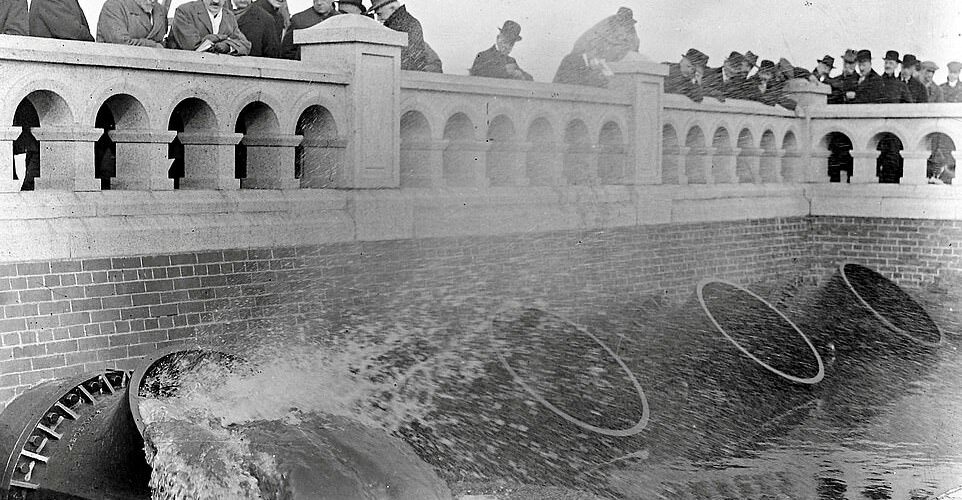London’s Water Supply Infrastructure

London’s water supply infrastructure has developed over the centuries in line with the expansion of London. Beginning in the 16 century, private companies supplied fresh water to parts of London from wells, the River Thames and the River Lea. Further demand prompted new sources, particularly when the Agricultural and Industrial Revolution caused a boom in London’s population and industry.
A crisis point was reached in the mid 19th century with the discovery that cholera arose from the extraction of water from the increasingly polluted Thames. The Metropolis Water Act 1852 banned this practice, allowing water companies three years to find other sources, but issues with contaminated water persisted. In 1904, London’s water suppliers were taken into municipal ownership as the Metropolitan Water Board, which substantially upgraded the water infrastructure, building many new reservoirs. Ownership subsequently passed to the Thames Water Authority, before being reprivatised in the 1980s.
London water supply in Earliest
Through to the late 16th century, London citizens turned to the tidal Thames for much of their non-drinking water. For drinking, due to the brackish and perceptibly poor taste of the Thames, they tended to rely on wells and tributaries rising in around a dozen natural springs on the north side of the Thames, restricting the city’s expansion south of the river.
In 1247 work began on the Great Conduit from the spring at Tyburn. This was a lead pipe which led via Charing Cross, Strand, Fleet Street and Ludgate to a large cistern or tank in Cheapside. The city authorities appointed “keepers of the conduits” who controlled access so that users such as brewers, cooks and fishmongers would pay for the water they used. Wealthy Londoners living near the conduits could obtain permission for a connection to their homes, but this did not prevent their unauthorized tapping. Otherwise – particularly for homes which could not take a gravity feed – water from the conduits was taken to homes by water carriers, often called cobs, a term seen as dated by the 18th century.
Great Stink and Cholera Outbreak
During the 19th century, rapid urbanization and inadequate waste disposal led to the infamous “Great Stink” of 1858, as the Thames became heavily polluted. This crisis, coupled with the devastating cholera outbreaks, underscored the urgent need for a more sophisticated water supply system.
Victorian Engineering Triumphs
Enter the Victorian engineers, most notably Sir Joseph Bazalgette. His ambitious sewer and water infrastructure projects, including the construction of the Thames Embankment and the sewer system, revolutionized London’s sanitation and significantly improved water quality. The innovative use of underground aqueducts helped bring fresh water to the city.
Reservoirs and Aqueducts
The late 19th and early 20th centuries saw the construction of reservoirs and aqueducts to meet the increasing demand. The Lee Valley Reservoir System, completed in 1904, exemplifies this era of expansion, ensuring a more robust and reliable water supply for a growing population.
Environmental Challenges
Despite these advancements, London faces ongoing challenges. Population growth, climate change, and concerns about water scarcity necessitate continued innovation and sustainable practices. Water conservation campaigns and investment in smart technologies play a vital role in mitigating these challenges.
Today’s Water Management
As of my last knowledge update in January 2022, Thames Water, the largest water and wastewater service provider in the UK, manages the water supply for London. Advanced treatment processes, rigorous quality monitoring, and a commitment to environmental sustainability are integral to the city’s contemporary water management.
Future Sustainability
Looking ahead, London’s water supply must navigate the complexities of climate change and population dynamics. Strategies involving water recycling, green infrastructure, and public awareness campaigns are key elements in building a sustainable and resilient water future for this iconic city.
Conclusion
In conclusion, London’s water supply is not merely a utilitarian infrastructure but a testament to human ingenuity and adaptability. From medieval wells to modern reservoirs, each chapter in this narrative reflects the city’s determination to overcome challenges and provide a vital resource for its inhabitants.








